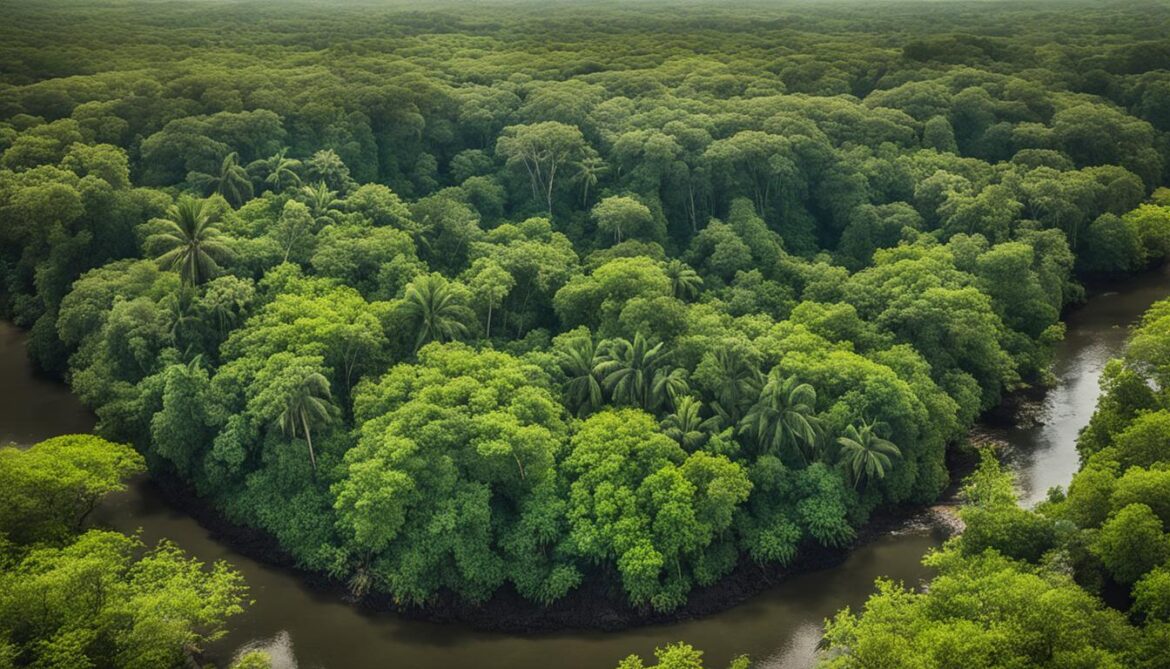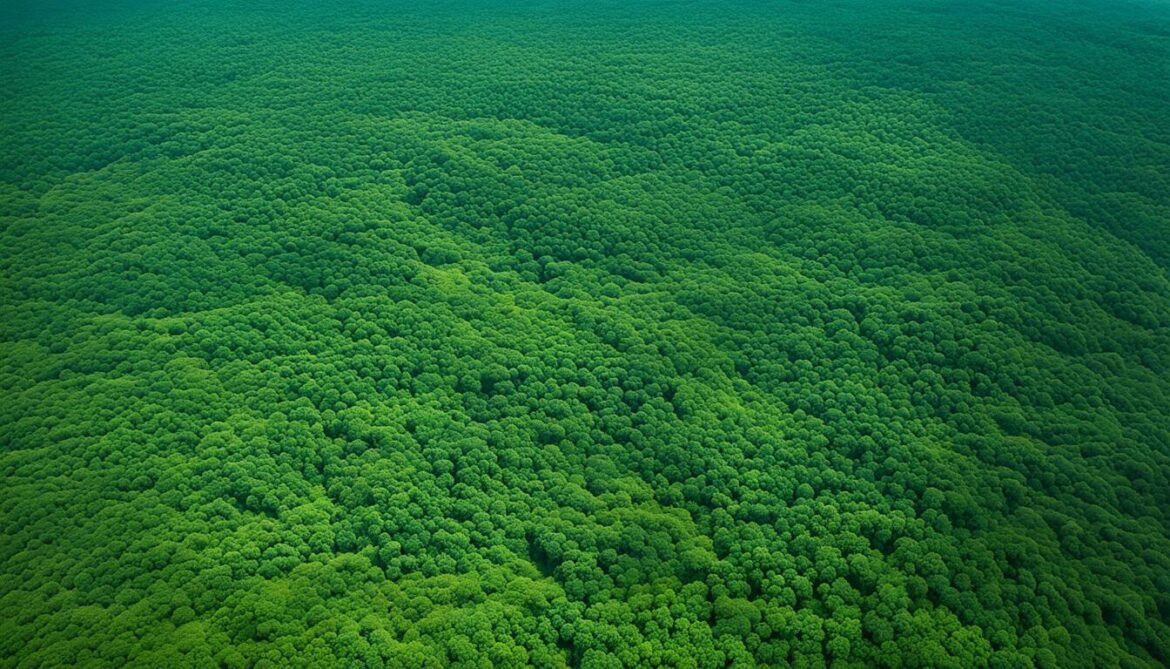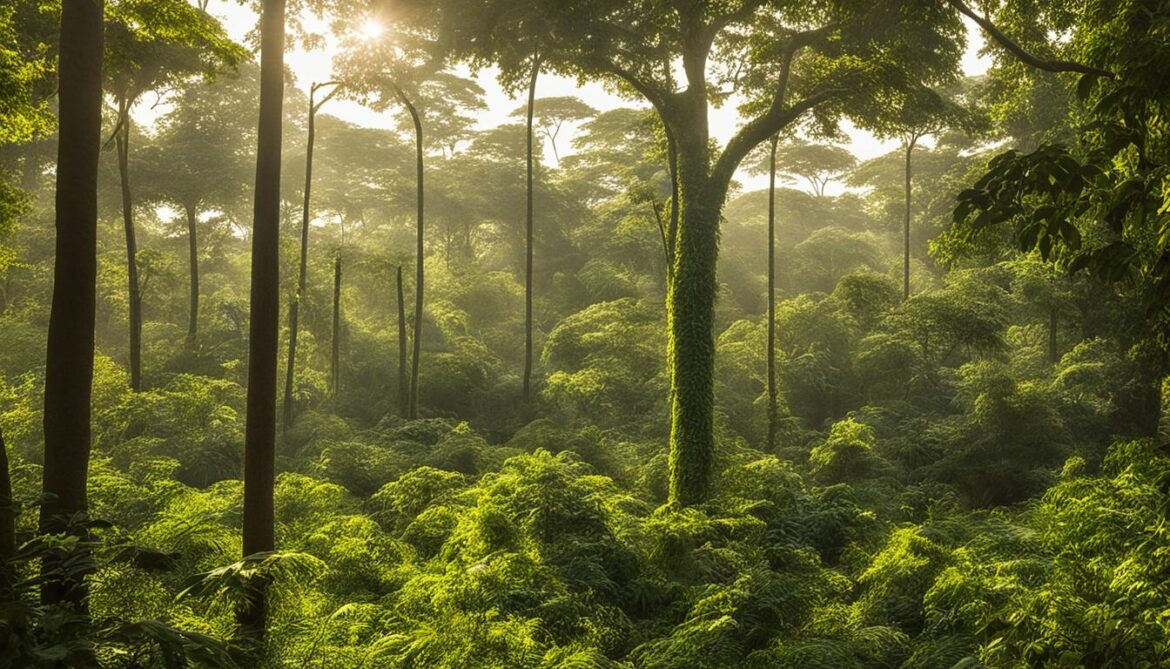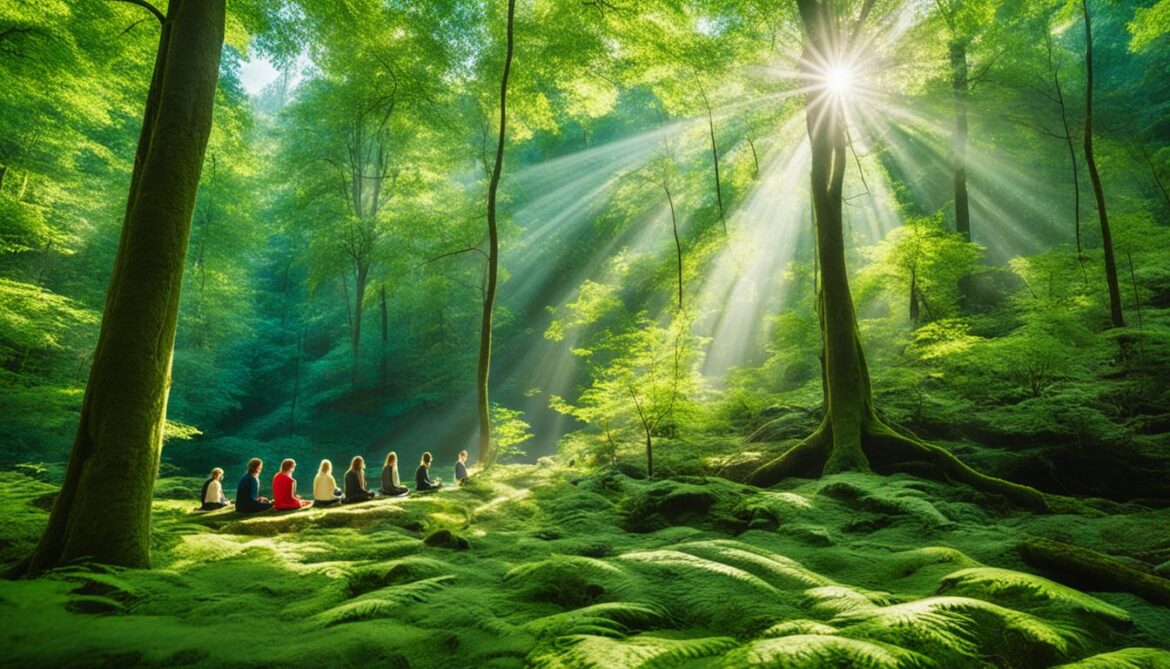Benin Sacred Natural Sites and Biodiversity
Did you know that Benin, a country in Western Africa, is home to approximately 2940 sacred forests covering an impressive area of 18,360 hectares? These sacred forests, though not legally protected by the state, have managed to preserve their resources through sustainable traditional management. Benin’s commitment to preserving its biodiversity through sacred natural sites, cultural landscapes, and traditional knowledge is truly remarkable.
Key Takeaways:
- Benin contains approximately 2940 sacred forests covering an area of 18,360 hectares.
- These sacred forests have maintained the integrity of their resources through sustainable traditional management.
- Benin recognizes the cultural, religious, and ecological importance of sacred forests.
- Growing demographic pressures and urbanization pose threats to Benin’s sacred forests.
- Aerial mapping and legal recognition of sacred forests play key roles in their protection and conservation.
Importance of Sacred Forests in Benin
Sacred forests in Benin hold significant socio-cultural and religious value. They serve as places of worship, rituals, and ceremonies, and provide economic functions such as the collection of deadwood, medicinal plants, and non-timber forest products. These forests are protected by traditional customs, and individuals found guilty of improper activities within these sacred forests can face penalties.
Moreover, sacred forests play a crucial role in biodiversity conservation, serving as refugia for numerous species and functioning as in-situ seed banks and genetic reservoirs. They also contribute to ecological benefits such as the protection of water sources, soil erosion prevention, and carbon sequestration.
“Sacred forests in Benin are not only places of spiritual significance but also serve as important ecological and economic resources,” says Dr. Marie Ange ISSAKA-TOURE, renowned environmentalist and researcher. “Their conservation is essential for the sustainable management of Benin’s ecosystems and the preservation of its rich biodiversity.”
“By guarding these sacred forests, communities in Benin are not only preserving their cultural heritage but also actively participating in the protection of biodiversity and ecosystem services,” says Jérémie GBETINON, a local conservationist. “These forests serve as living proof of the harmonious relationship between people and nature.”
Recognizing the importance of sacred forests, Benin has been making efforts to integrate these areas into its conservation strategies. This includes the involvement of local communities in the management of sacred forests and the development of sustainable practices that ensure the long-term preservation of these invaluable natural resources.
As the threats to ecosystems and biodiversity continue to increase worldwide, the preservation and conservation of sacred forests in Benin serve as an example for other countries and communities to follow. Understanding the value of these sacred natural sites and the role they play in sustaining both cultural and ecological diversity is crucial for achieving holistic landscape management and a sustainable future.
Types of Sacred Forests in Benin
Sacred forests in Benin hold immense cultural and religious significance. They are classified into various types based on their specific religious functions. These include:
Sacred Hunting Forest Reserves
Sacred hunting forest reserves are dedicated to the pursuit of traditional hunting activities. They serve as sanctuaries for wildlife and are important for preserving the delicate balance of the ecosystem. These forests play a vital role in Benin’s traditional knowledge conservation and cultural landscapes.
Forests of the Ancestors
The forests of the ancestors are revered as sacred spaces for conducting rituals and ceremonies related to ancestral worship. They are deeply ingrained in the community’s cultural beliefs and serve as a bridge between past generations and the present. These forests are held in high regard and are vital for sustaining Benin’s rich heritage.
Forests of the Dead
Forests of the dead are dedicated to the burial sites of ancestors and community members. They are regarded as sacred grounds and are treated with great respect. These forests provide a final resting place for loved ones and contribute to the preservation of Benin’s cultural identity.
Forests of the Gods and Spirits
Forests of the gods and spirits are inhabited by various deities and spirits according to traditional beliefs. These forests are considered sacred and are significant in Benin’s religious practices. They serve as spaces for worship, communication with the supernatural, and the preservation of spiritual traditions.
Forests of Secret Societies
Forests of secret societies are exclusively used for initiation ceremonies and rituals. They are shrouded in secrecy and play a crucial role in passing down traditional knowledge and cultural practices from one generation to another. These forests embody the essence of Benin’s cultural heritage and foster a sense of belonging within the community.
Each type of sacred forest in Benin holds its own unique significance and contributes to the country’s traditional knowledge conservation and cultural landscapes. These forests are intrinsically linked to the community’s identity and provide a tangible connection to their ancestral roots.

| Type of Sacred Forest | Religious Function |
|---|---|
| Sacred Hunting Forest Reserves | Preservation of traditional hunting activities and wildlife |
| Forests of the Ancestors | Rituals and ceremonies related to ancestral worship |
| Forests of the Dead | Burial sites for ancestors and community members |
| Forests of the Gods and Spirits | Accommodating various deities and spirits |
| Forests of Secret Societies | Initiation ceremonies and rituals |
Threats to Sacred Forests in Benin
Despite their importance, sacred forests in Benin face numerous threats that jeopardize their existence and the valuable ecosystem services they provide. Growing demographic pressures, urbanization, and a weakening of traditional authorities have created an environment of uncontrolled exploitation and degradation of these vital natural areas.
The rapid urbanization and population growth in Benin have led to increased land conversion, encroachment, and unsustainable resource extraction within sacred forests. These activities disrupt the delicate balance of the ecosystems and threaten the biodiversity they support. As a result, many sacred forests are disappearing, and their precious resources are being abused for short-term gains without consideration for long-term sustainability.
The delicate ecosystems of Benin’s sacred forests are being assaulted by the forces of urbanization and human exploitation. Immediate action is imperative to protect these ecosystems and the traditional knowledge and practices they embody.
The loss of traditional customs and the erosion of respect for taboos surrounding sacred forests have further contributed to their deterioration. As younger generations are less connected to their cultural heritage and traditions, they may not fully appreciate the significance of these forests, leading to the neglect of customary practices that protect them. Disrespect for taboos and traditional rules disrupts traditional governance systems and weakens the ability to enforce sustainable resource management.
It is essential to recognize the urgent need for action to address these threats and safeguard the remaining sacred forests in Benin. Efforts must be made to raise awareness about the importance of these forests, promote the revival of traditional knowledge, and strengthen the governance structures that have historically protected them.
To overcome these challenges, collaboration between government bodies, civil society organizations, and local communities is vital. By working together, these stakeholders can devise and implement effective strategies for the conservation and sustainable management of sacred forests in Benin. Such initiatives should be based on a combination of traditional and scientific knowledge, ensuring the long-term viability of these unique ecosystems.
A collective commitment to conserving Benin’s sacred forests is crucial not only for protecting its biodiversity but also for preserving its cultural and spiritual heritage. The preservation of these natural areas is a testament to the harmonious relationship between people and nature, serving as a model for global conservation efforts.

Aerial Mapping for Conservation Efforts
In an effort to preserve and restore the sacred forests of Benin, the municipal authorities of Ouidah collaborated with Benin Flying Labs to conduct aerial mapping missions. Utilizing drones, these missions provided a comprehensive assessment of the remaining areas of the sacred forests, revealing the extent of anthropogenic pressure and degradation.
The data obtained from these aerial mapping missions was shared with the government of Benin, leading to plans for halting further occupation of these forests and implementing restoration efforts for what remains. To ensure effective monitoring, regular overviews will be conducted to track the progress of the restoration initiatives.
| Benefits of Aerial Mapping for Conservation Efforts: |
|---|
| Detailed assessment of remaining sacred forests |
| Identification of anthropogenic pressure and degradation |
| Sharing vital data for government action |
| Development of restoration plans |
| Ongoing monitoring of restoration efforts |
“The aerial mapping missions have provided us with crucial information that will guide our conservation efforts for the sacred forests of Benin. By utilizing modern technologies, we can better understand the challenges these forests face and take appropriate action to protect them.” – Municipal Authorities of Ouidah
The collaborative efforts between municipal authorities and organizations like Benin Flying Labs demonstrate the commitment to preserve the sacred forests of Benin and the ecosystem they support. Through aerial mapping and subsequent actions, these conservation efforts aim to safeguard the rich biodiversity and cultural heritage associated with the sacred forests.

Legal Recognition of Sacred Forests in Benin
In 2012, Benin passed a national law that officially recognizes sacred forests and sites as protected areas. This groundbreaking law acknowledges the immense cultural and religious significance these forests hold, highlighting the communities that dedicate themselves to their preservation and governance. It stands as one of the few laws worldwide that duly acknowledge and protect Sacred Natural Sites and the custodian communities responsible for their care. This legal framework now safeguards these areas of exceptional importance, enabling the implementation of sustainable management practices and the integration of sacred forests into broader conservation efforts.

Preserving Biodiversity and Cultural Heritage
“The legal recognition of sacred forests in Benin marks a significant step towards the preservation of both biodiversity and cultural heritage. It establishes a foundation for sustainable management and ultimately ensures the continued existence of these unique ecosystems.”
The recognition of sacred forests in Benin has fostered an alliance between cultural heritage and biodiversity conservation. These forests serve as vital repositories of traditional knowledge, ingrained in customs, rituals, and centuries-old practices. Protecting and preserving these sacred sites not only safeguards invaluable cultural heritage but also creates an environment conducive to biodiversity conservation.
The Crucial Role of Legal Frameworks
Having legal recognition for sacred forests in Benin provides a framework for effective management and protection. The law empowers local communities and traditional custodians to maintain their sacred forests, ensuring these natural sites remain intact for future generations. Furthermore, it establishes guidelines that facilitate collaboration between governmental bodies, NGOs, and communities in their collective efforts to preserve and safeguard these areas of exceptional value.
Integration into Conservation Efforts
With legal recognition, sacred forests are now seamlessly integrated into broader conservation strategies. They are no longer seen as separate entities but instead as an integral part of Benin’s overall conservation landscape. This integration allows for more comprehensive and holistic approaches to biodiversity management, ensuring the long-term continuity of sacred forests and the invaluable resources they protect.
Partnerships for Conservation and Governance
The successful recognition and protection of sacred forests in Benin are the result of strong partnerships between civil society organizations, communities, and the government. Local NGOs like GRABE-Benin have played a significant role in advising and supporting the research and development of the national law for sacred forests. These partnerships are key to implementing conservation measures, reviving traditional knowledge and cultures, and protecting a network of sacred natural sites.
Collaboration between civil society organizations, communities, and the government has been crucial in the preservation of Benin’s sacred forests. Local NGOs, such as GRABE-Benin, have worked closely with the government, providing research, guidance, and support in the development of the national law for sacred forests. Through these partnerships, conservation measures have been implemented and traditional knowledge and cultural practices have been revitalized.
“Our partnership with GRABE-Benin has been invaluable in our efforts to protect and preserve Benin’s sacred forests. Their expertise and support have helped us develop effective conservation strategies that respect traditional knowledge and cultural practices while ensuring the long-term sustainability of these important ecosystems.” – Government Official
Working together, these partnerships have contributed to the successful recognition and legal protection of sacred forests in Benin. By combining the resources, knowledge, and expertise of civil society organizations, communities, and the government, a network of sacred natural sites has been safeguarded. This partnership approach is crucial for the continued conservation and management of these unique cultural and ecological landscapes.
Reviving Traditional Knowledge and Cultures
One of the key benefits of partnerships in conserving Benin’s sacred forests is the revival of traditional knowledge and cultural practices. Through collaborative efforts, local communities have been able to reconnect with their ancestral wisdom, preserving age-old traditions and rituals that are deeply intertwined with the natural environment.
- Partnering with local NGOs has allowed for the documentation and transmission of traditional knowledge related to sacred forests, ensuring its preservation for future generations.
- Communities have been empowered to take an active role in the management and governance of sacred forests, reestablishing their connection to these cultural landscapes.
- The sharing of traditional knowledge and cultural practices has fostered a sense of pride and identity among community members, strengthening their commitment to the conservation and protection of sacred forests.
Through partnerships, the revival of traditional knowledge and cultures has become a cornerstone of the conservation efforts in Benin. By valuing and incorporating these rich cultural practices, the protection of sacred forests goes beyond the preservation of biodiversity and becomes a holistic approach that respects the cultural heritage of the local communities.
Protecting a Network of Sacred Natural Sites
Partnerships have also played a crucial role in protecting and managing a network of sacred natural sites across Benin. These sites, consisting of sacred forests, hold immense cultural, ecological, and spiritual value and are interconnected through traditional beliefs and practices.
“By working together with civil society organizations and local communities, we have been able to establish a network of protected sacred natural sites across Benin. This collaborative approach ensures the long-term conservation of these unique landscapes and contributes to the overall biodiversity management efforts in the country.” – Environmental Conservation Agency Representative
Through partnerships, the protection of sacred natural sites has been integrated into national conservation strategies, ensuring the representation and preservation of these important areas within the broader biodiversity management framework. This collaborative approach acknowledges the significance of sacred forests in maintaining cultural heritage, fostering ecological resilience, and promoting sustainable development.

The Importance of Sacred Natural Sites Worldwide
The legal recognition of sacred forests in Benin is part of a larger global movement to acknowledge the importance of Sacred Natural Sites in biodiversity conservation and the preservation of traditional knowledge. Sacred Natural Sites are considered “No Go Areas” for destructive development and mining activities. They serve as important cultural and ecological landscapes and are governed by customary governance systems based on Earth’s laws. Protecting Sacred Natural Sites contributes to the health of ecosystems and the well-being of local communities.
Sacred Natural Sites are invaluable in promoting biodiversity conservation. These sites, often rich in unique and endangered species, provide a refuge for wildlife and plant species, helping to maintain a healthy balance in ecosystems. The traditional knowledge embedded within these sites holds the secrets to sustainable resource management, passed down through generations. By recognising and protecting Sacred Natural Sites, we unlock a wealth of traditional knowledge that can contribute to effective conservation strategies.
“Sacred Natural Sites are not just physical spaces but are also spiritual and cultural expressions of communities. They represent the interconnectedness of nature and culture, reminding us of our responsibilities as stewards of the Earth,” said Dr. Maria Silva, a renowned expert in biodiversity conservation.
Community governance is a crucial aspect of Sacred Natural Sites. Local communities often hold jurisdiction and have developed systems of customary laws and practices that govern these sites. This community-based governance ensures the sustainable use and management of natural resources, as decision-making processes prioritize the well-being of both the ecosystem and the people who depend on it.
The protection of Sacred Natural Sites is not only a matter of ecological importance but also a matter of social justice. These sites hold significant cultural, spiritual, and historical values for communities who have safeguarded them for generations. Recognizing and respecting the rights of these custodian communities is a step towards promoting cultural diversity, social inclusion, and intergenerational equity.
Preserving Sacred Natural Sites for Future Generations
Preserving Sacred Natural Sites is not just an obligation to the current generation but also a responsibility towards future generations. By safeguarding these sites, we ensure that future generations can continue to benefit from the vast ecological, cultural, and spiritual wealth they provide.
In order to protect and preserve Sacred Natural Sites worldwide, it is essential to promote international collaboration and knowledge sharing. Learning from the experiences of successful initiatives, such as the legal recognition of sacred forests in Benin, can inspire and guide innovative conservation approaches in different regions.
The recognition of the importance of Sacred Natural Sites worldwide has gained momentum in recent years, prompting governments, civil society organizations, and international institutions to work together to enhance their conservation and protection. By valuing these sites and integrating traditional knowledge and community governance systems into conservation efforts, we can ensure the preservation of these sacred landscapes for generations to come.

Protecting Sacred Natural Sites is not only a matter of environmental conservation but also a way to honor the wisdom and heritage of indigenous communities around the world. These sites embody a harmonious relationship between people and nature, reminding us of the profound interconnectivity of all life forms on Earth.
As we strive towards a sustainable future, it is crucial that we recognize, respect, and protect Sacred Natural Sites as vital elements of our shared natural and cultural heritage. Through collaborative efforts and a holistic approach to conservation, we can ensure the preservation of these sacred spaces and all the benefits they provide for our planet and humanity.
The Future of Sacred Forests in Benin and Beyond
The recognition and protection of Benin sacred forests have set a precedent for other countries and communities to follow. The collaboration between government bodies, NGOs, and local communities is crucial in safeguarding these important areas and preserving biodiversity. By combining efforts, we can ensure the continued existence of these Benin cultural landscapes and the rich traditional knowledge conservation they hold.
“The conservation of sacred forests and the integration of traditional knowledge and practices are integral to achieving holistic landscape management and a sustainable future.” – Ananya Sharma, Environmental Activist
Sacred Natural Sites are of global significance, and as threats continue to increase, it is essential to advocate for their recognition and protection on a global scale. The conservation of Benin sacred forests and the broader concept of Sacred Natural Sites contribute to the preservation of biodiversity and the well-being of local communities. These sites serve as important ecological and cultural landscapes, governed by customary systems rooted in respect for the Earth’s laws.
The Role of Sacred Forests in a Sustainable Future
In addition to their ecological significance, Benin sacred forests play a crucial role in achieving holistic landscape management and sustainability. These forests are not only repositories of unique biodiversity but also vital components of the cultural identity and traditional practices of local communities. By recognizing and protecting these forests, we can foster a sense of pride and ownership among communities, leading to their active participation in biodiversity management and conservation efforts.
Collaboration and Knowledge Exchange for Long-Term Impact
Collaboration between various stakeholders is key to the long-term preservation of Benin sacred forests and other Sacred Natural Sites. Government bodies, NGOs, researchers, and local communities must work together to develop effective management plans that combine the best of traditional knowledge and modern conservation practices.
- Capacity-building initiatives can empower local communities with the tools and knowledge needed to play an active role in managing and protecting these sacred forests.
- Research and monitoring programs can help in understanding the dynamics of these ecosystems, identifying potential threats, and implementing appropriate conservation strategies.
- International cooperation and knowledge exchange can promote the exchange of best practices, lessons learned, and innovative solutions in sacred forest conservation.
By fostering collaboration and knowledge exchange, we can strive towards a future where sacred forests are not only preserved but also celebrated as important cultural and ecological heritage.

The future of Benin sacred forests and Sacred Natural Sites worldwide depends on our commitment to their recognition, protection, and sustainable management. Through collective efforts, we can ensure the preservation of these unique ecosystems, the cultural practices they embody, and the invaluable traditional knowledge they hold. By embracing the value of Sacred Natural Sites, we pave the way for a sustainable future that respects and cherishes the interconnectedness of nature and humanity.
Conclusion
Benin’s sacred forests are remarkable ecosystems that play a vital role in both biodiversity conservation and preserving the country’s rich cultural heritage. However, these unique forests are currently facing various threats. The good news is that with collaborative efforts from different stakeholders, there is hope for their protection and restoration.
The experience in Benin serves as a powerful example, inspiring other countries and communities to recognize the value of sacred natural sites and take steps towards their conservation. Through innovative strategies like aerial mapping, which provides valuable data on the condition of these forests, and the legal recognition of their importance, Benin is making strides in protecting these vital habitats.
By cherishing and safeguarding these sacred forests, we not only ensure the preservation of valuable biodiversity but also contribute to the well-being of our planet and future generations. It is through such concerted efforts that we can continue to protect our natural heritage and create a more sustainable and harmonious world.
FAQ
What are Sacred Natural Sites in Benin?
How many sacred forests are there in Benin?
Do sacred forests in Benin have legal protection?
What is the significance of sacred forests in Benin?
How are sacred forests in Benin classified?
What are the threats to sacred forests in Benin?
How are aerial mapping missions used to preserve sacred forests in Benin?
Is there legal recognition and protection for sacred forests in Benin?
Who has played a significant role in the recognition and protection of sacred forests in Benin?
Why are Sacred Natural Sites important worldwide?
What is the future of sacred forests in Benin and beyond?
Source Links
- https://gaiafoundation.org/benins-historic-sacred-forest-law-translated-into-english/
- https://blog.flyinglabs.org/2023/10/25/preserving-benins-sacred-forests-the-power-of-aerial-mapping-in-biodiversity-conservation/
- https://satoyama-initiative.org/case_studies/benins-experience-in-the-management-of-sacred-forests-for-biodiversity-conservation/








